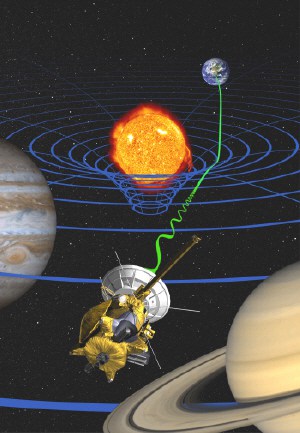Italian astrophysicists have confirmed the predictions of Einstein’s general theory of relativity with a precision that is about 50 times better than previous measurements. Bruno Bertotti of the University of Pavia and colleagues in Rome and Bologna measured how radio waves sent from the Earth to the Cassini satellite and back again were deflected by the Sun (B Bertotti et al. 2003 Nature 425 374). Their results, which are accurate to 20 parts in a million, agree with the predictions of general relativity.

In general relativity the fabric of space-time is curved by large masses. This curvature is responsible for the force of gravity, and also deflects and delays any photons passing near a large mass, such as the Sun. Previous experiments have measured these effects with an accuracy of 0.1% and found them to be in agreement with the predictions of the theory. Bertotti and colleagues used a new technique to test general relativity to much higher precision.
The Italian team took advantage of a chance alignment of the Earth, the Sun and Cassini – which is on its way to Saturn – that occurred in June last year. The experiment relied on Cassini’s 4-metre antenna and a new ground station at the NASA Deep Space Network in Goldstone, California. Bertotti and co-workers measured a parameter called gamma that is predicted to have a value of one in general relativity.
In the past astrophysicists measured either the deflection of radio waves caused by the Sun, or the increase in the round-trip time, to determine gamma. However, the Italian team measured how the round-trip time changed as a result of the motion of the Earth and the spacecraft. This involved measuring how the frequency of the microwave beam changed during its journey to Cassini and back. The team was able to determine this frequency shift with an accuracy of about one part in 1014.
“The main reason why this method has not been used before is because of the strong noise contribution due to the solar corona,” Bertotti told PhysicsWeb. “Our new measuring technique allows us to completely eliminate these strong disturbances.”
“This work is a significant improvement on measuring the curvature of space as predicted by Einstein,” said Clifford Will of Washington University in the US. “It was also a ‘piggy-back’ experiment because it used an existing mission to gather data and so was not expensive to perform.”
The team now hopes to repeat the measurement with higher precision to test for departures from general relativity that are predicted by some cosmological theories. However, a follow-up experiment planned for July of this year had to be cancelled due to an electronic malfunction on board Cassini.



